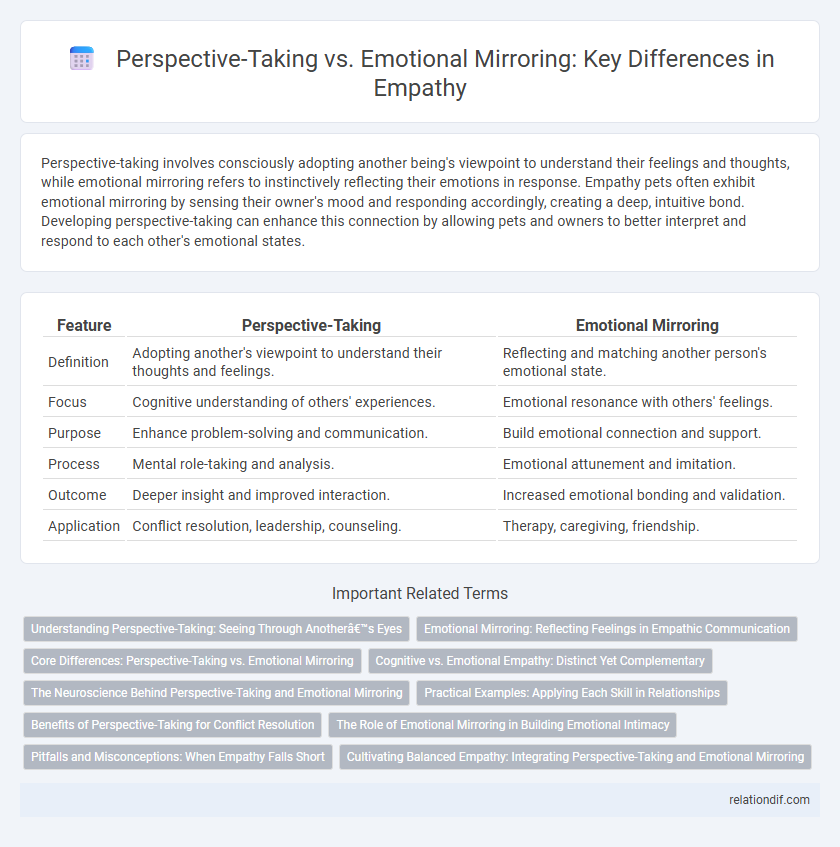Perspective-taking involves consciously adopting another being's viewpoint to understand their feelings and thoughts, while emotional mirroring refers to instinctively reflecting their emotions in response. Empathy pets often exhibit emotional mirroring by sensing their owner's mood and responding accordingly, creating a deep, intuitive bond. Developing perspective-taking can enhance this connection by allowing pets and owners to better interpret and respond to each other's emotional states.
Table of Comparison
| Feature | Perspective-Taking | Emotional Mirroring |
|---|---|---|
| Definition | Adopting another's viewpoint to understand their thoughts and feelings. | Reflecting and matching another person's emotional state. |
| Focus | Cognitive understanding of others' experiences. | Emotional resonance with others' feelings. |
| Purpose | Enhance problem-solving and communication. | Build emotional connection and support. |
| Process | Mental role-taking and analysis. | Emotional attunement and imitation. |
| Outcome | Deeper insight and improved interaction. | Increased emotional bonding and validation. |
| Application | Conflict resolution, leadership, counseling. | Therapy, caregiving, friendship. |
Understanding Perspective-Taking: Seeing Through Another’s Eyes
Perspective-taking involves cognitively stepping into another person's situation to understand their thoughts, feelings, and viewpoints without merging with their emotions. Emotional mirroring, in contrast, entails automatically matching another's emotional state, often leading to shared feelings but not necessarily deeper cognitive insight. Mastering perspective-taking enhances empathy by fostering nuanced understanding and informed responses rather than merely reflecting emotional experiences.
Emotional Mirroring: Reflecting Feelings in Empathic Communication
Emotional mirroring involves accurately reflecting another person's feelings through verbal and nonverbal cues, fostering a deeper empathic connection. This technique enhances emotional understanding by validating the speaker's experience, which promotes trust and openness in communication. Research indicates that emotional mirroring activates neural pathways associated with empathy, supporting effective relational bonding and emotional regulation.
Core Differences: Perspective-Taking vs. Emotional Mirroring
Perspective-taking involves cognitively adopting another person's viewpoint to understand their thoughts and motivations, while emotional mirroring entails subconsciously reflecting their feelings to establish emotional resonance. The core difference lies in perspective-taking being a deliberate process requiring mental effort, whereas emotional mirroring is an automatic, empathetic response rooted in neural mechanisms such as mirror neurons. Perspective-taking enhances cognitive empathy by fostering insight into others' experiences, whereas emotional mirroring strengthens affective empathy by sharing and validating emotional states.
Cognitive vs. Emotional Empathy: Distinct Yet Complementary
Perspective-taking involves cognitive empathy, where an individual intellectually understands another person's viewpoint without necessarily sharing their emotions. Emotional mirroring aligns with emotional empathy, allowing one to resonate with and reflect the feelings experienced by others. Both processes are distinct yet complementary, enhancing overall empathetic engagement by combining intellectual insight with emotional connection.
The Neuroscience Behind Perspective-Taking and Emotional Mirroring
Neuroscientific research reveals that perspective-taking activates the brain's medial prefrontal cortex and temporoparietal junction, areas crucial for understanding others' thoughts and intentions. Emotional mirroring engages the mirror neuron system, particularly in the inferior frontal gyrus and inferior parietal lobule, facilitating automatic empathic resonance with others' emotions. Distinct neural pathways underscore perspective-taking as a cognitive process and emotional mirroring as an affective response, collectively enhancing empathetic experiences.
Practical Examples: Applying Each Skill in Relationships
Perspective-taking involves actively imagining another person's thoughts and feelings, such as a manager considering an employee's workload before assigning tasks to foster understanding and cooperation. Emotional mirroring occurs when one reflects or matches another's emotional state, like a friend showing concern by sharing a similar tone and facial expressions during a difficult conversation. In relationships, perspective-taking promotes problem-solving by cognitive empathy, while emotional mirroring strengthens emotional bonds through affective empathy.
Benefits of Perspective-Taking for Conflict Resolution
Perspective-taking enhances conflict resolution by enabling individuals to understand opposing viewpoints, fostering greater empathy and reducing misunderstandings. This cognitive approach promotes collaborative problem-solving and effective communication, leading to mutually beneficial outcomes. Unlike emotional mirroring, which focuses on sharing feelings, perspective-taking encourages deeper insight into others' motivations and intentions, improving negotiation success.
The Role of Emotional Mirroring in Building Emotional Intimacy
Emotional mirroring plays a crucial role in building emotional intimacy by allowing individuals to accurately reflect and validate each other's feelings, creating a safe space for vulnerability. This process strengthens trust and deepens connections by fostering mutual understanding and emotional resonance. Unlike perspective-taking, which involves cognitively understanding another's viewpoint, emotional mirroring emphasizes shared emotional experiences that cultivate empathy and closeness.
Pitfalls and Misconceptions: When Empathy Falls Short
Perspective-taking involves cognitively understanding another person's viewpoint, while emotional mirroring entails sharing their feelings on an affective level; pitfalls arise when perspective-taking leads to projection or assumptions rather than genuine insight. Emotional mirroring can result in emotional contagion, causing burnout or blurred boundaries instead of constructive empathy. Misconceptions include equating empathy solely with feeling another's pain, which may hinder effective support and problem-solving.
Cultivating Balanced Empathy: Integrating Perspective-Taking and Emotional Mirroring
Cultivating balanced empathy involves integrating perspective-taking, which enhances cognitive understanding of others' thoughts, with emotional mirroring, which deepens affective connection by reflecting others' emotions. Research in social neuroscience identifies neural correlates such as the temporoparietal junction for perspective-taking and the mirror neuron system for emotional mirroring, highlighting the complementary roles each plays in empathetic interactions. Optimizing interpersonal communication and emotional intelligence requires harmonizing these mechanisms to foster both accurate interpretation and genuine emotional resonance.
Perspective-Taking vs Emotional Mirroring Infographic

 relationdif.com
relationdif.com